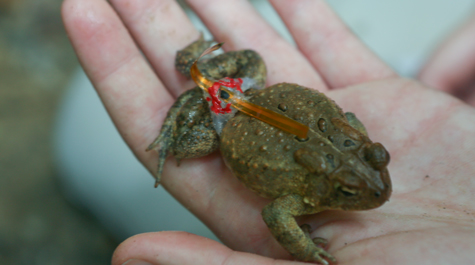Wrangling toads (for science)
And it’s a work in progress: William & Mary scientists are monitoring specimens of two pond-breeding toad species — the American toad (Anaxyrus americanus) and Fowler’s toad (Anaxyrus fowleri). Associate Professor of Biology Matthias Leu is trying to gain insight into the post-breeding habitat and habits of toads. He and a team of undergraduate researchers have fitted a few dozen local toads with high-tech backpacks to track their post-breeding movements.
The student toad trackers are going out by day and by night to locate the toads. They have found that, like humans, toads have individual preferences for where they like to hang out.
“From our landscape models, we know that the amount of forest around the pond is very important to explain whether or not a different species occurs in a pond,” Leu said. “So the questions we’re trying to answer are: Where do these toads go? Why is the forest around the pond so important?”
The toads are fitted with little backpacks — if you saw one on a human, you might call it a fanny pack. The backpacks each hold a transponder, which weighs less than a gram and uses RFID protocol that doesn’t require batteries, allowing a small, light device that a toad can tote without inconvenience.
The drawback of the battery-less technology is that the signal is distance-limited. Toad hunters must get within 10 to 15 meters of the toad to pick up the signal. Toads will be toads, and sometimes toads go underground, which cuts down on the signal strength some more.
Leu explained that an understanding of toad life is important because amphibian populations are declining worldwide, and most conservation efforts are focused on the spawning ponds. The toad trackers will continue the project into the future, but Leu says it’s become clear that the quantity and quality of the surrounding forest habitat is an important factor in maintaining toad populations.
“The pond is important for reproduction,” he said. “But with no forest around it, the pond does not matter anymore.”
Toad tracking for science involves taking a lot of data. In addition to noting GPS locations, the team records a slate of numbers regarding soil, moisture levels, breast-height diameter of nearby trees and more.
The scientific method does leave some room for sentiment, but the researchers are wary about becoming attached to any particular specimen. The students say that they have a curse and the second they start liking a toad it disappears.
“We had one that was doing really interesting movements and giving us really cool data,” says one of the student researchers. “She was really personable. Then we found her the next day and she was dead with her guts stringing out. We had named her Phoebe.”
Whether backpack-wearing toads is your thing or your curiosity is steeped in other topics, William & Mary has countless opportunities for students to get involved with undergraduate research.















